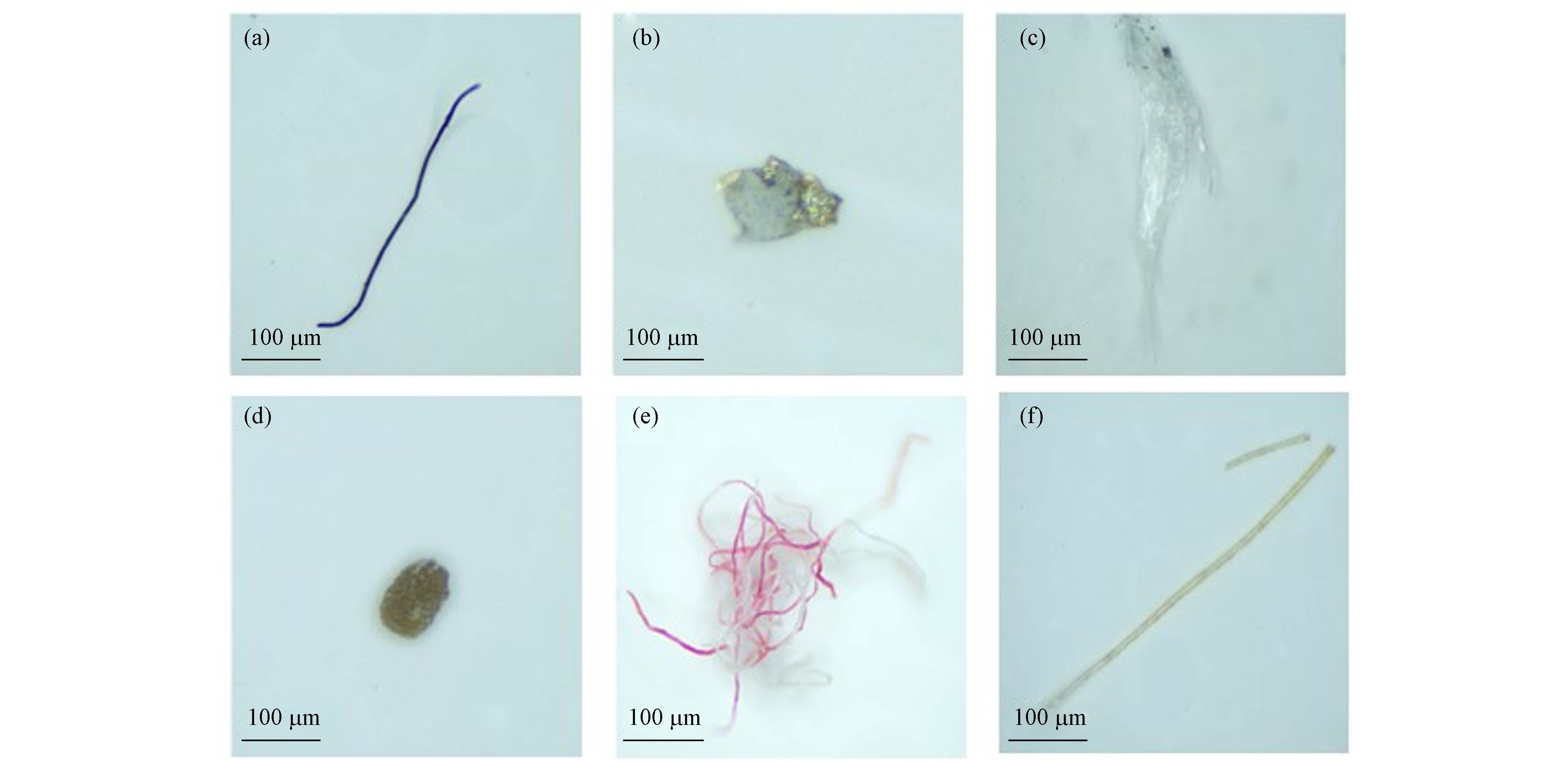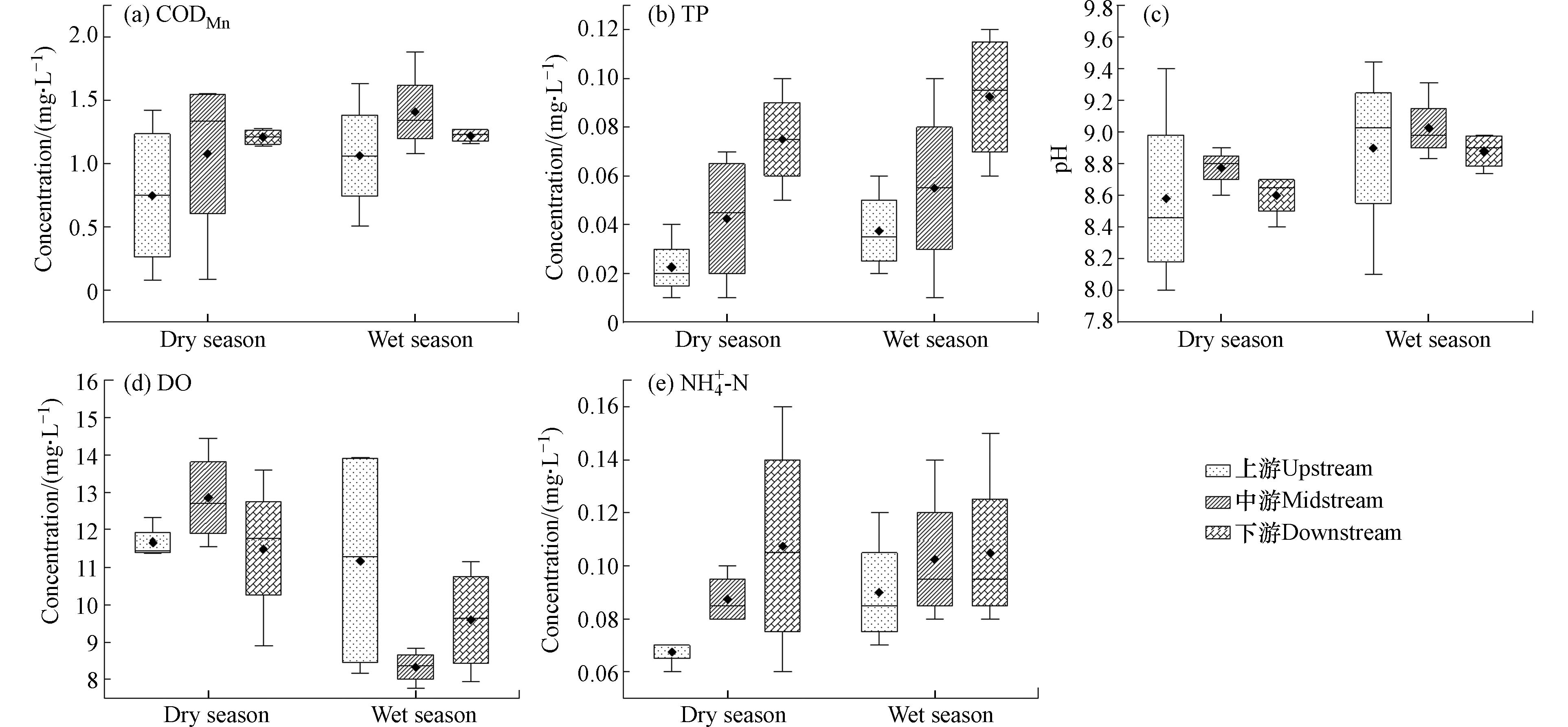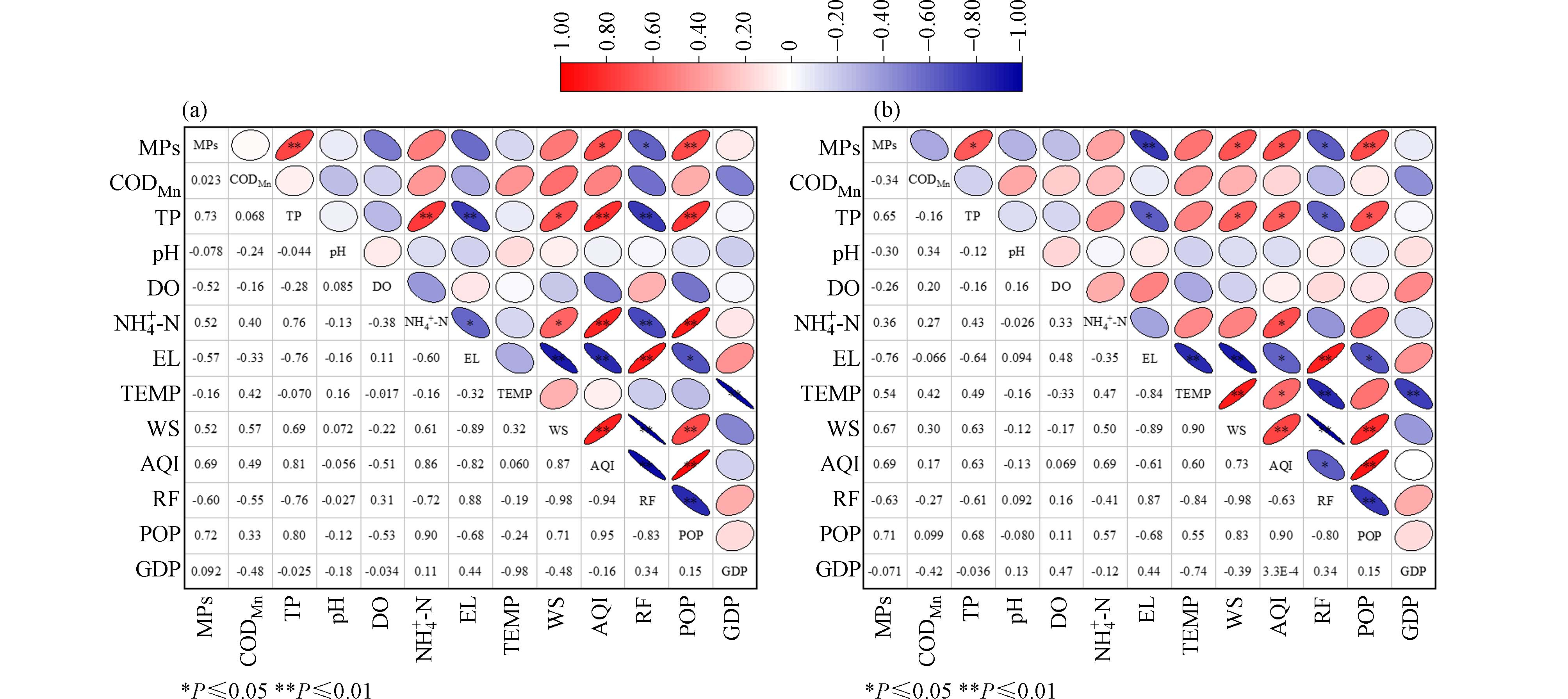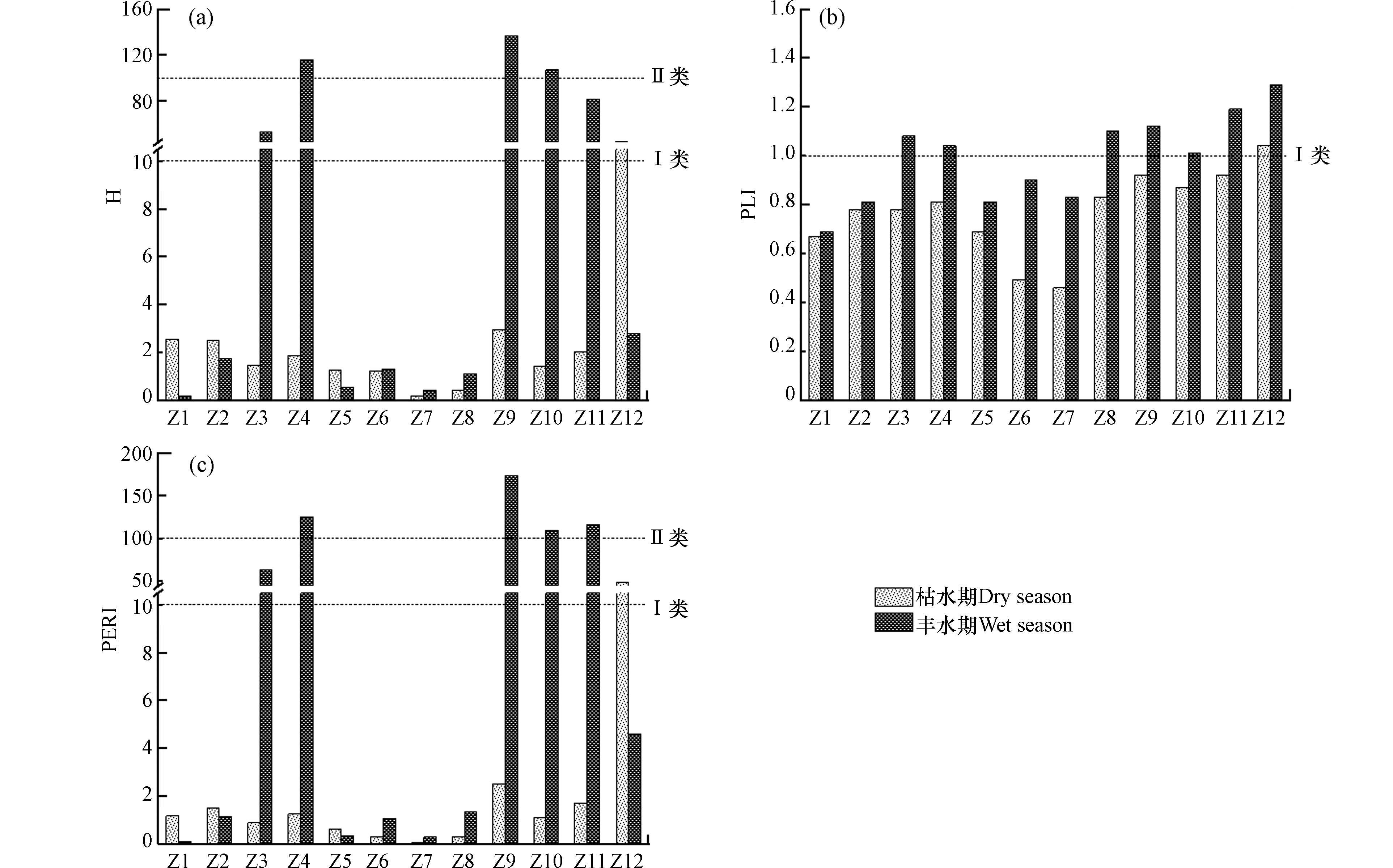-
塑料自20世纪问世起,因其低成本、材质轻、耐用性强等优势被广泛应用于社会的各个领域. 然而,塑料的大规模使用、低效的塑料回收措施以及塑料废弃物较差的自然降解性,使得塑料在环境中积累,对环境的负面影响日益明显[1 − 2]. 经过长期的光照、风力和水力侵蚀、微生物降解等作用断裂分解为粒径小于5 mm的颗粒[3],以及原生粒径小于5 mm的塑料(如沐浴露中的磨砂颗粒)[4]被称为“微塑料”[5]. 微塑料虽粒径较小但具有较大的比表面积,极易吸附环境中的重金属、有机污染物以及病原微生物[6],并被浮游动物、鱼类、哺乳动物、农作物[7]等生物体摄入或吸收[8],通过食物链转移到人类身上[9],进而对生态环境和人体健康造成潜在威胁.
大多数关于微塑料污染的研究都集中在海洋生态系统,它们被认为是微塑料的最终汇[10 − 11],微塑料主要来自陆地[1],而河流是陆地向海洋传输微塑料的重要载体,与人类的接触更为直接和频繁,其上游污染物的汇入、固体废物的丢弃及废水的排放等均是淡水环境中微塑料的来源[12]. 目前,中国对河流微塑料的研究主要集中在快速发展的东南地区大型河流上,如长江[13]、黄河[14]、钱塘江[15]和珠江[16],而对华北地区内陆水域的研究相对有限,特别是对小河流流域的调查分析. 大型河流和湖泊中的微塑料大部分来自小河流的流域[17],同时,小流域河流密集分布在内陆地区,与人类生产和生活密切相关,很可能是内陆淡水资源微塑料污染的重灾区,而内陆淡水资源大多从高山流向平原,然后进入干流流向大海[18]. 因此,探索小流域城市河流从山区向平原输送过程中微塑料的分布、变化特征及其影响因素十分必要.
漳河属华北地区海河流域漳卫南运河水系支流,发源于山西省东南部太行山腹地[19],流经山西、河南、河北三省,于河北省邯郸市大名、馆陶两县交界处注入卫河,全长460 km,流域面积
18284 km2. 漳河是中国北方地区重要的水源之一,同时也是重要的农业生产区之一,对于保障当地的水资源安全、农业发展和旅游业都具有重要意义. 然而,目前未见有关漳河流域微塑料污染状况的研究,因此,本文以漳河流域邯郸段为研究对象,探讨了从山区到平原的城市河流地表水微塑料分布特征和影响因素,并对该区域微塑料污染进行生态风险评估,以补充从山区到平原的小流域河流微塑料污染的相关研究,并为漳河流域邯郸段微塑料污染防控和水质生态安全提供科学数据. -
邯郸市位于河北省南端,太行山东麓,是京津冀协同发展和中原经济区区域性中心城市. 漳河由清漳河、浊漳河和漳河干流三部分组成. 清漳河自郭家村北入邯郸境至合漳村长约61 km,浊漳河自张家头村西入邯郸境至合漳村长约21 km. 漳河干流自西而东,横贯磁县、临漳县、魏县、大名县至馆陶县徐万仓长约179 km,其中控制邯郸境内流域面积
2863 km2. -
选取邯郸境内漳河流域为研究对象,共设置12个采样点(图1),上游流经太行山区设置了4个采样点(Z1—Z4),中游流经山区、丘陵和平原地带设置了4个采样点(Z5—Z8),下游流经平原区设置了4个采样点(Z9—Z12). 于2023年7月和12月采集漳河邯郸段表层水样,取样前用去离子水冲洗不锈钢采水器,在岸边一定距离处采集0—20 cm深度的表层水,每个采样点水样取5 L,重复采集两次,分装于两个5 L的大玻璃瓶中,作为两个现场平行样品. 采用深达威SW-M500激光测距仪测量河道宽度(表1),使用哈希HQ30D便携式多参数水质测定仪现场测定酸碱度(pH)和溶解氧(DO),采集后的样品瓶置于冰袋上低温保存运回实验室以便后续处理. 一部分用于微塑料的提取,一部分用于高锰酸盐指数(CODMn)(GB
11892 —1989)、总磷(TP)(GB11893 —1989)和氨氮(HJ 535—2009)的测定. -
水样通过0.012 mm的不锈钢筛网进行初步过滤,再用5 μm乙酸硝酸纤维滤膜进行抽滤,将滤膜置于干净的250 mL烧杯中,加入30%的H2O2溶液,置于超声波清洗器中10 min,再加入30%的H2O2溶液冲洗滤膜,确保将滤膜上的残留物全部转移至干净烧杯中. 将烧杯置于恒温水浴锅中60 ℃水浴3 h,再室温静置12 h,待充分消解完后用不锈钢筛网过滤,加入饱和氯化锌溶液(ρ=1.5 g·cm−3)进行密度浮选,重复3次,使用5 μm的乙酸硝酸纤维滤膜抽滤其上清液,将滤膜放入干净的培养皿中,60 ℃烘干待测. 然后使用奥斯微体式显微镜(AOSVI T2-3M180,深圳市奥斯微光学仪器有限公司,中国)通过ImageJ1.51拍照记录滤膜上微塑料的形貌特征,最后采用傅立叶变换红外光谱仪(IRAffinity-1S,岛津企业管理(中国)有限公司,中国)在光谱范围为
4000 —400 cm−1,光谱分辨率为0.09 cm−1的条件下对微塑料进行扫描分析,与从岛津企业管理(中国)有限公司购买的IRAffinity-1S标准谱图库进行匹配,命中率超过70%方可确定聚合物成分[20]. -
为减少实验误差,防止潜在的微塑料污染,野外采样和实验过程中穿戴棉质实验服和丁腈手套,对于可能会受到污染的器具,使用前用去离子水多次清洗. 实验时用铝箔纸覆盖暴露于空气中的样品及器皿,使用空白滤膜进行对照,结果表明,空白对照组中微塑料数量较少,为(0.56±0.15)n·m−3,在后续各样品中计算微塑料丰度时均减去相应空白实验的微塑料丰度.
-
采用生态风险指数(H)[21]、污染物负荷指数(PLI)[22]和潜在生态风险指数法(PERI)[23]评估邯郸市漳河微塑料的污染风险. 微塑料风险指数(H)计算公式如下:
式中,H为微塑料的风险指数;Pi为水体中各类型微塑料的质量分数;Si为各类微塑料聚合物的危险评分. 其中聚乙烯(PE)、聚丙烯(PP)、聚酰胺(PA)、聚丁烯(PB)、聚苯乙烯(PS)、聚氯乙烯(PVC)、聚氨酯(PU)、聚对苯二甲酸乙二醇酯(PET)、苯乙烯-异戊二烯-苯乙烯嵌段共聚物(SIS)、乙烯-醋酸乙烯共聚物(EVA)所对应的危险评分分别是11、1、47、6、30、
10551 、7384 、4、10、9[24].污染物负荷指数评估模型定义如下:
式中,CFi为微塑料污染系数;Ci为各点位微塑料实测丰度;Coi为微塑料丰度参考值,此处参考Everaert等[23]计算出的表层水体中微塑料安全丰度(
6650 n·m−3)[25 − 29];PLIi为各点位微塑料污染负荷指数;n为点位个数;PLIzone为研究区域微塑料污染负荷指数.潜在生态风险指数法评估模型定义如下:
式中,PERIi为样本i的潜在生态风险指数,PERIzone为研究区域潜在生态风险指数. 表2为3种模型对应的风险级别划分标准[26,30].
-
使用ArcGIS10.8软件绘制采样点位分布图,Excel 2021整理实验数据,SPSS 27进行皮尔森相关性分析,Origin2022绘制相关图表.
-
漳河流域邯郸段12个采样点样品中微塑料丰度如图2(a)所示,所有表层水样中均检测出一定丰度的微塑料. 枯水期微塑料丰度范围为
1400 —7200 n·m−3,平均丰度为(4133 ±1674 )n·m−3;丰水期微塑料丰度范围为3200 —11000 n·m−3,平均丰度为(6717 ±2350 )n·m−3. 在时间尺度上,微塑料丰度表现为丰水期>枯水期,其中Z6点丰水期微塑料丰度(5400 n·m−3)约为其枯水期(1600 n·m−3)的3倍. 在空间分布上(图2(b)),漳河枯水期表层水微塑料平均丰度表现为中游(2700 ±1501 )n·m−3)<上游(3850 ±597)n·m−3)<下游(5850 ±943)n·m−3),漳河丰水期表层水微塑料平均丰度表现为上游(5650 ±2205 )n·m−3)与中游(5600 ±1657 )n·m−3)相近,下游微塑料平均丰度(8900 ±1763 )n·m−3)最高,漳河流域水体微塑料丰度表现出明显的时空差异. 漳河流域位于太行山以东的迎风面,暴雨多集中于汛期,特别是七八月份,环境中的微塑料可能由于风力或降水迁移造成该流域内微塑料丰度升高[31 − 32]. 与其他小流域河流相比(表3),漳河流域水体微塑料含量低于北京的北运河[33]、越南的西贡河[34]以及日本的阿瓦诺河和阿萨河[35],与湖北的香溪河[36]微塑料含量相当,高于苏州的苏州河[37]和山东的大沽河[38],微塑料含量处于中等水平,与大流域河流[15,39 − 45]和中国沿海海域[46]相比,漳河流域水体微塑料含量处于中上等水平,水体类型划分参考(《联合国水质评价》第二版),将大河和特大河流划分为大流域河流,河流及其以下划分为小流域河流. 经济发展、人口密度和自然地理特征的变化是微塑料污染区域差异化的重要原因[18].漳河水样中高出微塑料平均丰度的点位几乎都位于人口密集区和农业区,Z3点周围有两所学校和一个集镇,且处于通往磁县、林县的要道,微塑料丰度较高. Z4点附近旅游景点较为密集,周围有商业娱乐设施,经济发展相对较好,微塑料丰度较高. Z8点位于岳城水库的下游出水口,而水库对微塑料具有一定的滞留与富集作用[47],微塑料丰度较高. Z9—Z12点周围有大量农田,村庄较多且位于邯郸段下游,微塑料丰度相对较高. 而Z1、Z2、Z5、Z6和Z7点位于山区且周围村庄较少,微塑料丰度相对较低. 已有研究表明水体中微塑料丰度与流域人口密度、GDP、地形等因素具有显著相关性[13,48]. 从总体上看(图1),漳河表层水从上游到下游微塑料丰度呈递增的趋势,随着海拔的降低,微塑料的丰度显著增加. 一方面可能是漳河流域邯郸段上中游穿行于太行山的崇山峻岭之中,自然植被多,耕地面积小,人为干扰小以致该段整体微塑料丰度偏低,下游流经平原区,周围城市化程度高,耕地面积大,人口密集,田地中的农业生产及城区居民各类生活生产等活动以致该段微塑料丰度明显升高. 另一方面可能是上游水体中未降解的微塑料随着河流的流动在下游富集,微塑料通过不同的途径从高海拔地区向低海拔地区迁移,在平原形成了累积效应[49].
-
漳河水体中微塑料的主要形状可分为:纤维、碎片、薄膜、颗粒、纤维团和棒状6类(图3),微塑料形状占比见图4(a). 本研究中微塑料的形状以纤维(75.9%—77.4%)为主,与淮河流域安徽段水体(76.1%)[29]、武汉城市地表水(79.5%)[50]、长江入海口表层水体(79.7%)[51]等研究结果相似. 其次是薄膜(6.9%—9.4%)和碎片(5.0%—8.1%),在枯水期与丰水期中薄膜状微塑料占比最高的点位均是Z10,整体而言,下游的薄膜状微塑料占比相对较高,这可能是因为下游流经区域属于重要农业区,农用地膜和塑料大棚使用量大以致农业活动中残留大量的塑料制品,在环境中风化破碎形成薄膜状塑料进入水体[30]. 与薄膜状微塑料不同,碎片状微塑料占比最高的点位均是Z8(岳城水库下游出水口),这可能与岳城水库内渔民与居民活动产生的包装袋和塑料容器等塑料制品破碎有关.
经体式显微镜检测出不同颜色的微塑料,如图4(b)所示,表层水中微塑料颜色有蓝色、黑色、透明色、黄色、红色和绿色共6种颜色,主要以蓝色为主,枯水期与丰水期的蓝色占比为44.7%—55.2%,其次是透明色(20.2%—26.8%)和黄色(13.3%—17.1%),黑色(6.5%—7.4%)、红色(2.2%—3.6%)和绿色(1.2%—1.7%)最为少见. 颜色是推测微塑料来源的重要特征之一[52],枯水期和丰水期的彩色(蓝色、黄色、红色和绿色)占比分别为73.3%和65.7%,已有研究[53]发现,彩色被广泛应用于塑料制品中用来提高其市场竞争力,这可能是彩色微塑料占比较高的重要原因;透明色微塑料可能来源于塑料袋、尼龙网及农业薄膜等透明塑料制品,此外还可能由其他有色微塑料风化褪色而来[54]. 黑色微塑料可能来源于农用黑色地膜及汽车轮胎,由于Z7点靠近道路及耕地,周围人烟稀少,这也诠释了为何Z7点黑色微塑料丰度最高. 此外,漳河水体中微塑料颜色呈现出多样化特征,表明这些微塑料来源较为宽泛.
本文将微塑料粒径分为5类:<0.1 mm、0.1—0.5 mm、0.5—1 mm、1—2 mm和2—5 mm. 由图4(c)可见,0.1—0.5 mm的微塑料粒径占比最高,分别为32.0%和33.1%,其次是0.5—1 mm(27.8%—28.8%)和1—2 mm(22.3%—24.6%),而<0.1 mm(2.7%—4.0%)和2—5 mm(10.5%—14.1%)粒径的微塑料占比较少. 从整体上看,漳河水体中的微塑料粒径大多分布在<2 mm(85.9%—89.5%)的区间,这与巢湖水体微塑料粒径50 μm—2 mm(88.65%)[55]和武汉市地表水微塑料粒径小于2 mm(80%以上)[50]研究结果相似. 这些尺寸较小的微塑料可能是一些尺寸较大的塑料碎片在光氧化、机械磨损和生物作用下破碎和降解形成的[56 − 57]. 相对其他点位而言,Z8—Z12点粒径分布较为宽泛包含0—5 mm各类粒径大小的微塑料,这可能是由于水样流经下游重要农业区,易受人为干扰,河流中的微塑料新老交替,导致了下游水体中微塑料粒径参差不齐.
使用傅立叶变换红外光谱仪鉴定微塑料的聚合物成分,共检测出10种聚合物类型,如图4(d)所示,主要的聚合物类型有聚乙烯(PE)、聚丙烯(PP)、聚酰胺(PA)和聚丁烯(PB). 其中PE、PP和PA占比较高,这3种聚合物类型在所有样品中的平均占比超过了80%,在夏季采集的水样中检测出PA的占比低于冬季的水样,而冬季采集的水样中PE和PP的占比相对较高. PA俗称尼龙,是一种用途非常广泛的塑料,主要来源有纺织物、化工机械零件、医疗用品等,此外PA塑料还可用于制作棒材及板材,漳河水样中的棒状塑料检测的聚合物成分均为PA. PE是农用地膜的主要成分[58],在农业活动中常用于地膜覆盖,采样时在Z10和Z12点附近发现了有农用地膜覆盖的农田,这可能是漳河下游水样中薄膜状塑料PE占比较高的原因. PP塑料广泛应用于农业、渔业、纺织业等,冬季采集到的碎片状微塑料占比相对增大,纤维状微塑料占比相对减少,但这两种形状的微塑料对应的PP含量相对升高. 因而推测PP塑料一方面来源于流域周边居民洗涤衣物、纺织面料等产生的生活污水直接或间接流入漳河,另一方面来源于鱼线或捕鱼网的脱落. 这表明漳河流域邯郸段水体微塑料污染受人们日常生活和生产的影响,这也是纤维状微塑料在水体中占比较高的原因之一.
-
河流生态系统中微塑料的丰度是动态变化的,与溶解负荷的化学品不同,微塑料是悬浮负荷,其空间分布受自然条件和人类活动的影响[59 − 60]. 由于漳河流域(邯郸段)西南高、东北低,流经山地、丘陵和平原,选择涉县、磁县、临漳县和魏县为主要研究区域,各县2023年度社会经济数据来自中经数据. 不同时期的各区域水质指标分布见图5,从上游到下游,各区域地表水的高锰酸盐指数(CODMn)、总磷(TP)、酸碱度(pH)和氨氮(NH4+-N)浓度均表现为枯水期<丰水期. 氮、磷是评定水体富营养化和污染情况的重要指标,两个时期内各区域总磷含量较高,浓度集中在0.02—0.09 mg·L−1,氨氮浓度集中在0.07—0.11 mg·L−1,共有67%的样点达到国家制定的《地表水环境质量标准(GB3838—2002)》中的Ⅱ类标准(≤0.1 mg·L−1),约有8%的样点达到Ⅲ类标准(≤0.2 mg·L−1). 为进一步探究水体微塑料丰度与水质指标的关系,对其进行Pearson相关性分析(图6),两个时期内微塑料丰度与酸碱度和溶解氧均呈负相关,与总磷和氨氮均呈正相关,枯水期与总磷呈极显著正相关(P<0.01),丰水期与总磷呈显著正相关(P<0.05),这表明水体微塑料丰度可能与氮磷污染物具有相同的来源. 已有研究表明,随着水质的下降,微塑料丰度会显著上升[61]. 漳河流域氨氮和总磷的最高浓度均出现在下游,同时下游也是微塑料丰度最高的区域,这可能与下游城市化水平较高有关,生活用水中的氮、磷元素较多,再叠加下游重要农业区所需的氮肥,加速了地表营养元素流向水体.
漳河流域2023年枯水期与丰水期的气象数据(中国气象数据网)见表4,研究区域各类因子具有明显的时空差异. 与枯水期相比,研究区域丰水期平均气温显著升高23.43 ℃,风速显著提高1.05 km·h−1,降雨量显著增加10—24倍,但空气指数降低了46.6,而空气指数越高,空气质量越差,即研究区域丰水期空气质量相对较好. 根据地形和海拔高度将漳河流域划分为3种地势:山地、山地-平原过渡区和平原,涉县位于山地,磁县位于山地-平原过渡区,临漳县和魏县位于平原. 从空间分布来看,两个时期内各区域平均风速与空气指数均表现为山地<山地-平原过渡区<平原,空气质量与降雨量则表现为山地>山地-平原过渡区>平原.
漳河流域水体微塑料丰度与当地自然条件和人类活动的相关性如图6所示,两个时期内,水体微塑料丰度与空气指数呈显著正相关(P<0.05),与降雨量呈显著负相关(P<0.05),与人口呈极显著正相关(P<0.01);枯水期,水体微塑料丰度与各县地区生产总值(GDP)和风速呈正相关;丰水期,水体微塑料丰度与海拔呈极显著负相关(P<0.01),与风速呈显著正相关(P<0.05). 地形变化是漳河流域水体微塑料丰度变化的重要原因,已有研究发现,微塑料的丰度随着海拔的升高而降低,可能是由于生物和非生物因素的共同作用,从高海拔地区迁移到平原[62];而环境中质量较轻的微塑料可以在空气中通过风被传输至偏远地区[12];漳河是典型的季节性河流,汛期洪水随降雨而生,降雨后短期内会通过地表径流将环境中的微塑料输送至河流使微塑料丰度升高,但长时间雨水的冲刷会稀释河流中的微塑料使其浓度降低[63];在上海市区河流和长江干流中,人口密集和发达的经济条件被认为是微塑料含量高的主要因素之一[13],这表明城市及地区经济发展和人类活动对水体中的微塑料分布有一定的影响. 综上所述,漳河流域水体微塑料分布不仅受当地人类活动、社会经济和自然地理特征的影响,还与风速、空气指数、降雨量等气象因子密切相关.
-
本研究选取生态风险指数(H)、污染负荷指数(PLI)和潜在生态风险指数法(PERI)对漳河邯郸段表层水进行生态风险评估. 各采样点的生态风险指数及风险等级见图7(a),漳河流域枯水期表层水总体生态风险指数为62.43,风险等级为Ⅱ级,除了Z12点的风险指数处于10—100之间,风险等级为Ⅱ级,其它采样点的风险指数均处于1—10之间,风险等级为Ⅰ级. 而Z12点采集的水样中检测出含有较高毒性系数的PVC,虽然占比仅有0.4%,但会带来极高的生态风险. 漳河流域丰水期表层水总体生态风险指数为503.19,风险等级为Ⅲ级,各采样点的风险指数差异较大,其中Z1、Z2、Z5—Z8、Z12的7个点位的风险等级为Ⅰ级,Z3和Z11两个点位的风险等级为Ⅱ级,Z4、Z9、Z10的3个点位的风险等级为Ⅲ级,在风险等级为Ⅱ—Ⅲ级的点位中检测出毒性系数较高的PVC(毒性系数为
10551 )和PU(毒性系数为7384 ),整体占比分别为3.2%和2.0%,所以少量的高毒性聚合物可能会造成区域生态风险较高.由于生态风险指数(H)只考虑单一聚合物毒性及其点位占比进行量化评估[27],而未将微塑料丰度计算在内以致存在一定的局限性,因而结合污染负荷指数(PLI)以微塑料丰度为指标对漳河(邯郸段)表层水进行生态风险评价. 如图7(b)所示,漳河流域枯水期表层水各采样点微塑料污染负荷指数(PLI)值范围在0.46—1.04,整体区域水体污染负荷指数(PLIzone)值为0.75,风险等级为Ⅰ级,属于轻微污染. 丰水期各采样点微塑料污染负荷指数(PLI)值范围在0.69—1.29,整体区域水体污染负荷指数(PLIzone)值为0.98,风险等级为Ⅰ级,属于轻微污染,这与生态风险指数(H)模型计算得出的风险等级迥异,已有研究表明,微塑料的丰度与生态风险指数(H)没有明显的相关性,但高丰度的微塑料可能会导致潜在的生态风险[64].
而潜在生态风险指数法(PERI)结合了微塑料的丰度及单一聚合物的毒性,能够能全面地评估水体中微塑料的生态风险. 各采样点微塑料潜在生态风险指数及风险等级见图7(c),漳河流域枯水期与丰水期表层水总体潜在生态风险指数分别为0.98和5.60,风险等级均为Ⅰ级,属于低生态风险,但部分点位潜在生态风险值较高,风险等级达到Ⅱ—Ⅲ级,这与生态风险值较高的点位高度一致,这说明微塑料的生态风险不仅与丰度有关,更与聚合物类型有关[25]. 综上所述,漳河邯郸段整体的微塑料污染程度较低,但少量的高毒性聚合物会给局部区域带来潜在的生态风险. 因此,在保持现状的前提下,漳河流域需加强微塑料污染防治工作,禁止使用易释放有毒物质的塑料,避免污染的进一步恶化.
-
(1)漳河流域水体微塑料普遍存在微塑料污染,其分布表现出明显的时空差异,微塑料平均丰度丰水期(
6717 ±2350 )n·m−3>枯水期(4133 ±1674 )n·m−3,高出微塑料平均丰度的点位几乎都位于人口密集区和经济发达区,从上游到下游呈递增的趋势. 微塑料含量受经济发展、人口密度和自然地理特征的综合影响.(2)漳河流域水体微塑料形状主要以纤维(75.9%—77.4%)为主,颜色以蓝色(44.7%—55.2%)为主,粒径主要分布在0—2 mm(85.9%—89.5%)的区间,聚合物成分主要以PE、PP和PA为主. 微塑料的形态和类型主要受流域内居民生活生产方式的影响.
(3)漳河流域水体微塑料丰度与总磷和氨氮呈正相关,与空气指数和降雨量呈显著相关,而与人口呈极显著正相关. 微塑料分布受当地自然条件和人类活动的综合作用,可得出环境因子是影响漳河流域水体微塑料分布的重要因素.
(4)风险评估模型显示,漳河流域水体整体的微塑料污染程度较低,部分区域生态风险等级达到Ⅱ—Ⅲ级,少量高毒性聚合物会造成局部区域高生态风险,因此,在微塑料生态风险防控的同时,应注重高毒性聚合物的控制.
漳河邯郸段水体微塑料分布特征及影响因素
Characteristics of microplastic distribution and influencing factors in the water body of Handan section of Zhanghe River
-
摘要: 微塑料作为环境中的一种新型污染物已引起社会的广泛关注,为探究微塑料在城市河流中的时空分布特征及其影响因素,以漳河邯郸段为研究对象,于2023年7月和12月选取了12个点位采集表层水样,通过实验室预处理、体式显微镜观察和傅立叶变换红外光谱仪鉴定等分析了漳河流域邯郸段水体微塑料的分布特征,综合环境因子开展相关性分析,并依据生态风险指数、污染负荷指数和潜在生态风险指数对微塑料污染进行风险评估. 结果表明,漳河水体微塑料平均丰度丰水期(
6717 ±2350 )n·m−3>枯水期(4133 ±1674 )n·m−3,从上游到下游呈递增的趋势;其中,纤维状(75.9%—77.4%)、蓝色(44.7%—55.2%)、粒径0—2 mm(85.9%—89.5%)的微塑料占据主导地位,聚合物成分以PE、PP和PA为主;微塑料丰度与总磷和氨氮呈正相关,与空气指数和降雨量呈显著相关,而与人口呈极显著正相关,微塑料分布受当地自然条件和人类活动的综合影响;生态风险评估模型显示,总体上该区域微塑料污染程度较低,部分点位风险指数较高,其潜在风险应引起重视. 该研究结果可为从山区到平原的城市河流微塑料污染治理提供参考.Abstract: As a novel type of environmental pollutant, microplastics have attracted widespread attention in society. To explore the spatial and temporal distribution characteristics of microplastics in urban rivers and their influencing factors, this study focused on the Handan section of the Zhanghe River. Surface water samples were collected from 12 sites in July and December 2023. The distribution characteristics of microplastics in the water of the Handan section were analyzed through laboratory preprocessing, microscopic observation, and identification using Fourier Transform Infrared Spectroscopy (FTIRS). Correlation analysis was conducted with environmental factors, and risk assessment of microplastic pollution was performed based on the ecological risk index, pollution load index, and potential ecological risk index. The results indicated that the average abundance of microplastics in the water column of Zhanghe River was higher during the wet season (6717 ±2350 ) n·m−3 than during the dry season (4133 ±1674 ) n·m−3, showing an increasing trend from upstream to downstream. Dominant types of microplastics included fibrous (75.9%—77.4%), blue (44.7%—55.2%), and microplastics sized 0—2mm (85.9%—89.5%), with polyethylene (PE), polypropylene (PP), and polyamide (PA) as the main polymer compositions. The abundance of microplastics was positively correlated with total phosphorus and ammonia nitrogen, significantly correlated with air quality index and rainfall, and exhibited a highly significant positive correlation with population. This suggests that the distribution of microplastics is influenced by a combination of local natural conditions and human activities. The ecological risk assessment model indicated that the overall level of microplastic contamination in the region is low, however, certain sites exhibited high-risk indices, warranting attention to their potential risks. The findings of this study can provide a reference for the management of microplastic pollution in urban rivers from mountainous to plain regions. -

-
表 1 漳河各采样点河道宽度
Table 1. Zhanghe river channel width of each sampling site
采样点
Sampling siteZ1 Z2 Z3 Z4 Z5 Z6 Z7 Z8 Z9 Z10 Z11 Z12 河道宽度/ m 141.0 162.0 43.3 87.4 142.0 136.7 168.0 521.0 130.6 51.1 230.0 74.3 表 2 微塑料生态风险等级
Table 2. Risk classification of microplastics
项目
Project风险等级
Risk levelⅠ Ⅱ Ⅲ Ⅳ 生态风险指数(H) <10 10—100 100— 1000 > 1000 污染负荷指数(PLIzone) <10 10—20 20—30 >30 潜在生态风险指数(PERI) <10 10—100 100— 1000 1000 —10000 表 3 世界各地淡水环境中微塑料丰度的比较
Table 3. Comparison of the abundance of microplastics in freshwater environments around the world
研究区域
Study area地点
Location丰度/(n·m−3)
Abundance水体类型
Types of water参考文献
Reference北运河 中国 3100 —22100 小流域河流 [33] 西贡河 越南 172000 —519000 小流域河流 [34] 阿瓦诺河、阿萨河 日本 164790 ±171910 小流域河流 [35] 香溪河 中国 5000 ±1070 —6640 ±1320 小流域河流 [36] 苏州河 中国 80— 7400 小流域河流 [37] 大沽河 中国 600— 3800 小流域河流 [38] 珠江流域 中国 2990 —9870 大流域河流 [39] 钱塘江 中国 1500 —9400 大流域河流 [15] 长江流域 中国 0— 44080 大流域河流 [40] 渭河 中国 3670 —10700 大流域河流 [41] 塞纳河 法国 100.6±99.9 大流域河流 [42] 尼罗河 非洲 2240 ±600—3760 ±1100 大流域河流 [43] 湄公河 越南 53.8±140.7 大流域河流 [44] 茨瓦伦克河 印度 5850 ±3280 大流域河流 [45] 沿海海域 中国 680— 6440 海洋 [46] 漳河邯郸段水体 中国 4133 ±1674 —6717 ±2350 小流域河流 本研究 表 4 研究区域两个时期主要气象因子的月均值
Table 4. Annual average values of the main meteorological factors in the study area
研究区域
Study area时期
Period气温/℃
Temperature风速/(km·h−1)
Wind speed空气指数
Air quality index降雨量/mm
Rainfall涉县 枯水期 1.67±2.08 7.63±1.97 92.67±7.37 11.07±16.69 丰水期 23.70±3.17 7.66±1.26 52.40±8.32 119.04±151.56 磁县 枯水期 1.67±2.08 9.37±0.35 99.00±7.00 5.77±4.59 丰水期 25.40±3.60 10.22±2.10 53.80±10.38 76.28±39.19 临漳县 枯水期 1.17±2.57 10.17±1.40 103.33±13.32 2.23±2.11 丰水期 24.90±3.83 11.30±2.48 53.80±10.08 41.12±41.58 魏县 枯水期 1.00±2.78 9.60±1.39 111.00±14.73 2.23±2.04 丰水期 25.20±3.40 11.80±2.61 59.60±10.31 53.62±57.63 -
[1] AUTA H S, EMENIKE C U, FAUZIAH S H. Distribution and importance of microplastics in the marine environment: A review of the sources, fate, effects, and potential solutions[J]. Environment International, 2017, 102: 165-176. doi: 10.1016/j.envint.2017.02.013 [2] FARACA G, ASTRUP T. Plastic waste from recycling centres: Characterisation and evaluation of plastic recyclability[J]. Waste Management, 2019, 95: 388-398. doi: 10.1016/j.wasman.2019.06.038 [3] BROWNE M A. Sources and pathways of microplastics to habitats[M]//Marine Anthropogenic Litter. Cham: Springer International Publishing, 2015: 229-244. [4] COLE M, LINDEQUE P, HALSBAND C, et al. Microplastics as contaminants in the marine environment: A review[J]. Marine Pollution Bulletin, 2011, 62(12): 2588-2597. doi: 10.1016/j.marpolbul.2011.09.025 [5] THOMPSON R C, OLSEN Y, MITCHELL R P, et al. Lost at sea: Where is all the plastic?[J]. Science, 2004, 304(5672): 838. doi: 10.1126/science.1094559 [6] 陈雅兰, 孙可, 高博. 微塑料吸附机制研究进展[J]. 环境化学, 2021, 40(8): 2271-2287. doi: 10.7524/j.issn.0254-6108.2021031204 CHEN Y L, SUN K, GAO B. Sorption behavior, mechanisms, and models of organic pollutants and metals on microplastics: A review[J]. Environmental Chemistry, 2021, 40(8): 2271-2287 (in Chinese). doi: 10.7524/j.issn.0254-6108.2021031204
[7] LI L Z, LUO Y M, LI R J, et al. Effective uptake of submicrometre plastics by crop plants via a crack-entry mode[J]. Nature Sustainability, 2020, 3: 929-937. doi: 10.1038/s41893-020-0567-9 [8] EERKES-MEDRANO D, THOMPSON R C, ALDRIDGE D C. Microplastics in freshwater systems: A review of the emerging threats, identification of knowledge gaps and prioritisation of research needs[J]. Water Research, 2015, 75: 63-82. doi: 10.1016/j.watres.2015.02.012 [9] ZHANG J J, WANG L, TRASANDE L, et al. Occurrence of polyethylene terephthalate and polycarbonate microplastics in infant and adult feces[J]. Environmental Science & Technology Letters, 2021, 8(11): 989-994. [10] LI B, LI B W, JIA Q P, et al. Source or sink role of an urban lake for microplastics from Guangdong-Hong Kong-Macao greater bay area, China[J]. Environmental Research, 2023, 224: 115492. doi: 10.1016/j.envres.2023.115492 [11] CHAU H S, XU S P, MA Y, et al. Microplastic occurrence and ecological risk assessment in the eight outlets of the Pearl River Estuary, a new insight into the riverine microplastic input to the northern South China Sea[J]. Marine Pollution Bulletin, 2023, 189: 114719. doi: 10.1016/j.marpolbul.2023.114719 [12] JIANG C B, YIN L S, LI Z W, et al. Microplastic pollution in the rivers of the Tibet Plateau[J]. Environmental Pollution, 2019, 249: 91-98. doi: 10.1016/j.envpol.2019.03.022 [13] ZHANG Z Q, DENG C N, DONG L, et al. Microplastic pollution in the Yangtze River Basin: Heterogeneity of abundances and characteristics in different environments[J]. Environmental Pollution, 2021, 287: 117580. doi: 10.1016/j.envpol.2021.117580 [14] HAN M, NIU X R, TANG M, et al. Distribution of microplastics in surface water of the lower Yellow River near estuary[J]. Science of the Total Environment, 2020, 707: 135601. doi: 10.1016/j.scitotenv.2019.135601 [15] DAI L Y, WANG Z Y, GUO T J, et al. Pollution characteristics and source analysis of microplastics in the Qiantang River in Southeastern China[J]. Chemosphere, 2022, 293: 133576. doi: 10.1016/j.chemosphere.2022.133576 [16] YANG G Q, GONG M T, MAI L, et al. Diversity and structure of microbial biofilms on microplastics in riverine waters of the Pearl River Delta, China[J]. Chemosphere, 2021, 272: 129870. doi: 10.1016/j.chemosphere.2021.129870 [17] WANG G L, LU J J, LI W J, et al. Seasonal variation and risk assessment of microplastics in surface water of the Manas River Basin, China[J]. Ecotoxicology and Environmental Safety, 2021, 208: 111477. doi: 10.1016/j.ecoenv.2020.111477 [18] 胡玥. 秦岭渭河交接带河水中微塑料催化裂解合成碳纳米管[D]. 杨凌: 西北农林科技大学, 2021. HU Y. Carbon nanotubes synthesized from microplastics in the Chin Ling-Weihe River transition zone by catalytic pyrolysis[D]. Yangling: Northwest A & F University, 2021 (in Chinese).
[19] 马文奎, 王建刚, 阎永军. 湿润漳河行动计划的思考[J]. 中国防汛抗旱, 2010, 20(1): 16-17,36. MA W K, WANG J G, YAN Y J. Thoughts on wetting Zhanghe action plan[J]. China Flood & Drought Management, 2010, 20(1): 16-17,36 (in Chinese).
[20] LIU J, ZHANG X, DU Z F, et al. Application of confocal laser Raman spectroscopy on marine sediment microplastics[J]. Journal of Oceanology and Limnology, 2020, 38(5): 1502-1516. doi: 10.1007/s00343-020-0129-z [21] XU P, PENG G Y, SU L, et al. Microplastic risk assessment in surface waters: A case study in the Changjiang Estuary, China[J]. Marine Pollution Bulletin, 2018, 133: 647-654. doi: 10.1016/j.marpolbul.2018.06.020 [22] TOMLINSON D L, WILSON J G, HARRIS C R, et al. Problems in the assessment of heavy-metal levels in estuaries and the formation of a pollution index[J]. Helgolä nder Meeresuntersuchungen, 1980, 33(1): 566-575. [23] EVERAERT G, VAN C L, DE R M, et al. Risk assessment of microplastics in the ocean: Modelling approach and first conclusions[J]. Environmental Pollution, 2018, 242: 1930-1938. doi: 10.1016/j.envpol.2018.07.069 [24] LITHNER D, LARSSON Å, DAVE G. Environmental and health hazard ranking and assessment of plastic polymers based on chemical composition[J]. Science of the Total Environment, 2011, 409(18): 3309-3324. doi: 10.1016/j.scitotenv.2011.04.038 [25] 周添红, 张佳倩, 闵芮, 等. 刘家峡水库微塑料的赋存特征及其风险评估[J]. 中国环境科学, 2023, 43(11): 6007-6015. doi: 10.3969/j.issn.1000-6923.2023.11.038 ZHOU T H, ZHANG J Q, MIN R, et al. Occurrence characteristics and risk assessment of microplastics in Liujiaxia reservoir[J]. China Environmental Science, 2023, 43(11): 6007-6015 (in Chinese). doi: 10.3969/j.issn.1000-6923.2023.11.038
[26] 李思琼, 王华, 储林佑, 等. 长江流域微塑料污染特征及生态风险评价[J]. 环境科学, 2024, 45(3): 1439-1447. LI S Q, WANG H, CHU L Y, et al. Pollution characteristics and ecological risk assessment of microplastics in the Yangtze River Basin[J]. Environmental Science, 2024, 45(3): 1439-1447 (in Chinese).
[27] 丁爽, 李卫明, 张续同, 等. 宜昌市东山运河微塑料污染评估及年排放量估算[J]. 环境科学, 2024, 45(3): 1448-1456. DING S, LI W M, ZHANG X T, et al. Assessment of microplastic pollution and estimation of annual emission volume in the Dongshan canal of Yichang City[J]. Environmental Science, 2024, 45(3): 1448-1456 (in Chinese).
[28] 李沛钊, 吴莉, 黄菲菲, 等. 桂林市不同功能型公园水体微塑料的分布特征及风险评估[J]. 环境科学, 2023, 44(4): 2062-2071. LI P Z, WU L, HUANG F F, et al. Distribution characteristics and risk assessment of microplastics in water of different functional parks in Guilin[J]. Environmental Science, 2023, 44(4): 2062-2071 (in Chinese).
[29] 张海强, 高良敏, 葛娟, 等. 淮河流域安徽段水体和沉积物微塑料赋存特征及风险评估[J]. 环境科学, 2023, 44(9): 5036-5045. ZHANG H Q, GAO L M, GE J, et al. Occurrence characteristics and risk assessment of microplastics in water and sediments of Anhui section of Huaihe River Basin[J]. Environmental Science, 2023, 44(9): 5036-5045 (in Chinese).
[30] 范梦苑, 黄懿梅, 张海鑫, 等. 湟水河流域地表水体微塑料分布、风险及影响因素[J]. 环境科学, 2022, 43(10): 4430-4439. FAN M Y, HUANG Y M, ZHANG H X, et al. Distribution, risk, and influencing factors of microplastics in surface water of Huangshui River Basin[J]. Environmental Science, 2022, 43(10): 4430-4439 (in Chinese).
[31] FAN Y F, ZHENG J L, DENG L G, et al. Spatiotemporal dynamics of microplastics in an urban river network area[J]. Water Research, 2022, 212: 118116. doi: 10.1016/j.watres.2022.118116 [32] JIA Q L, DUAN Y S, HAN X L, et al. Atmospheric deposition of microplastics in the megalopolis (Shanghai) during rainy season: Characteristics, influence factors, and source[J]. Science of the Total Environment, 2022, 847: 157609. doi: 10.1016/j.scitotenv.2022.157609 [33] 何文宣, 李垒, 孙思宇, 等. 北运河水体、沉积物和鱼类中微塑料的分布特征研究[J]. 生态环境学报, 2023, 32(11): 1901-1912. HE W X, LI L, SUN S Y, et al. Distribution characteristics of microplastics in water, sediment and fish in Beiyun river[J]. Ecology and Environmental Sciences, 2023, 32(11): 1901-1912 (in Chinese).
[34] LAHENS L, STRADY E, KIEU-LE T C, et al. Macroplastic and microplastic contamination assessment of a tropical river (Saigon River, Vietnam) transversed by a developing megacity[J]. Environmental Pollution, 2018, 236: 661-671. doi: 10.1016/j.envpol.2018.02.005 [35] KABIR A H M E, SEKINE M, IMAI T, et al. Assessing small-scale freshwater microplastics pollution, land-use, source-to-sink conduits, and pollution risks: Perspectives from Japanese Rivers polluted with microplastics[J]. Science of the Total Environment, 2021, 768: 144655. doi: 10.1016/j.scitotenv.2020.144655 [36] 陈圣盛, 李卫明, 张坤, 等. 香溪河流域微塑料的分布特征及其迁移规律分析[J]. 环境科学, 2022, 43(6): 3077-3087. CHEN S S, LI W M, ZHANG K, et al. Distribution characteristics of microplastics and their migration patterns in Xiangxi River Basin[J]. Environmental Science, 2022, 43(6): 3077-3087 (in Chinese).
[37] LUO W Y, SU L, CRAIG N J, et al. Comparison of microplastic pollution in different water bodies from urban creeks to coastal waters[J]. Environmental Pollution, 2019, 246: 174-182. doi: 10.1016/j.envpol.2018.11.081 [38] 张鹏举, 蓝洁, 张凯璇, 等. 大沽河流域微塑料在不同介质中的空间分布及其潜在来源探究[J]. 环境化学, 2023, 42(12): 4093-4103. doi: 10.7524/j.issn.0254-6108.2022052607 ZHANG P J, LAN J, ZHANG K X, et al. Spatial distribution and potential sources of microplastics in different media of Dagu River basin[J]. Environmental Chemistry, 2023, 42(12): 4093-4103 (in Chinese). doi: 10.7524/j.issn.0254-6108.2022052607
[39] HUANG D F, LI X Y, OUYANG Z Z, et al. The occurrence and abundance of microplastics in surface water and sediment of the West River downstream, in the south of China[J]. Science of the Total Environment, 2021, 756: 143857. doi: 10.1016/j.scitotenv.2020.143857 [40] YANG H, SUN F H, LIAO H Q, et al. Distribution, abundance, and risks posed by microplastics in surface waters of the Yangtze River Basin, China[J]. Environmental Pollution, 2023, 333: 122086. doi: 10.1016/j.envpol.2023.122086 [41] DING L, MAO R F, GUO X T, et al. Microplastics in surface waters and sediments of the Wei River, in the northwest of China[J]. Science of the Total Environment, 2019, 667: 427-434. doi: 10.1016/j.scitotenv.2019.02.332 [42] DRIS R, GASPERI J, ROCHER V, et al. Synthetic and non-synthetic anthropogenic fibers in a river under the impact of Paris megacity: Sampling methodological aspects and flux estimations[J]. Science of the Total Environment, 2018, 618: 157-164. doi: 10.1016/j.scitotenv.2017.11.009 [43] KHEDRE A M, RAMADAN S A, ASHRY A, et al. Abundance and risk assessment of microplastics in water, sediment, and aquatic insects of the Nile River[J]. Chemosphere, 2024, 353: 141557. doi: 10.1016/j.chemosphere.2024.141557 [44] KIEU-LE T C, THUONG Q T, TRUONG T N S, et al. Baseline concentration of microplastics in surface water and sediment of the northern branches of the Mekong River Delta, Vietnam[J]. Marine Pollution Bulletin, 2023, 187: 114605. doi: 10.1016/j.marpolbul.2023.114605 [45] ALAM F C, SEMBIRING E, MUNTALIF B S, et al. Microplastic distribution in surface water and sediment river around slum and industrial area (case study: Ciwalengke river, majalaya district, Indonesia)[J]. Chemosphere, 2019, 224: 637-645. doi: 10.1016/j.chemosphere.2019.02.188 [46] QU X Y, SU L, LI H X, et al. Assessing the relationship between the abundance and properties of microplastics in water and in mussels[J]. Science of the Total Environment, 2018, 621: 679-686. doi: 10.1016/j.scitotenv.2017.11.284 [47] DI M X, WANG J. Microplastics in surface waters and sediments of the Three Gorges Reservoir, China[J]. Science of the Total Environment, 2018, 616: 1620-1627. [48] BIAN P Y, LIU Y X, ZHAO K H, et al. Spatial variability of microplastic pollution on surface of rivers in a mountain-plain transitional area: A case study in the chin Ling-Wei River plain, China[J]. Ecotoxicology and Environmental Safety, 2022, 232: 113298. doi: 10.1016/j.ecoenv.2022.113298 [49] ZHOU Y F, HE G, JIANG X L, et al. Microplastic contamination is ubiquitous in riparian soils and strongly related to elevation, precipitation and population density[J]. Journal of Hazardous Materials, 2021, 411: 125178. doi: 10.1016/j.jhazmat.2021.125178 [50] WANG W F, NDUNGU A W, LI Z, et al. Microplastics pollution in inland freshwaters of China: A case study in urban surface waters of Wuhan, China[J]. Science of the Total Environment, 2017, 575: 1369-1374. doi: 10.1016/j.scitotenv.2016.09.213 [51] ZHAO S Y, ZHU L X, WANG T, et al. Suspended microplastics in the surface water of the Yangtze Estuary system, China: First observations on occurrence, distribution[J]. Marine Pollution Bulletin, 2014, 86(1/2): 562-568. [52] PENG G Y, ZHU B S, YANG D Q, et al. Microplastics in sediments of the Changjiang Estuary, China[J]. Environmental Pollution, 2017, 225: 283-290. doi: 10.1016/j.envpol.2016.12.064 [53] WANG W F, WANG J. Comparative evaluation of sorption kinetics and isotherms of Pyrene onto microplastics[J]. Chemosphere, 2018, 193: 567-573. doi: 10.1016/j.chemosphere.2017.11.078 [54] 刘咏雪. 贵阳市南明河流域微塑料分布特征及风险评估研究[D]. 贵阳: 贵州大学, 2022. LIU Y X. Distribution characteristics and risk assessment of microplastics in Nanming River Basin of Guiyang[D]. Guiyang: Guizhou University, 2022 (in Chinese).
[55] 陈馨, 张仲伟, 刘运钊, 等. 巢湖水体中微塑料组成及分布特征[J]. 环境科学研究, 2022, 35(12): 2716-2721. CHEN X, ZHANG Z W, LIU Y Z, et al. Compositional and distributional characteristics of microplastics in water samples of Chaohu Lake[J]. Research of Environmental Sciences, 2022, 35(12): 2716-2721 (in Chinese).
[56] RODRIGUES M O, ABRANTES N, GONÇALVES F J M, et al. Spatial and temporal distribution of microplastics in water and sediments of a freshwater system (Antuã River, Portugal)[J]. Science of the Total Environment, 2018, 633: 1549-1559. doi: 10.1016/j.scitotenv.2018.03.233 [57] 万顺, 徐国策, 李清顺, 等. 大理河流域微塑料空间分布及其来源[J]. 环境科学学报, 2022, 42(8): 293-303. WAN S, XU G C, LI Q S, et al. Spatial distribution and source of microplastics in the Dali River Basin[J]. Acta Scientiae Circumstantiae, 2022, 42(8): 293-303 (in Chinese).
[58] 杨海龙, 刘楠, 白保勋, 等. 农田土壤微塑料来源、分离及检测研究进展[J]. 河南化工, 2022, 39(12): 1-4. doi: 10.3969/j.issn.1003-3467.2022.12.hnhg202212001 YANG H L, LIU N, BAI B X, et al. Research progress of the source, separation and detection of microplastics in farmland soil[J]. Henan Chemical Industry, 2022, 39(12): 1-4 (in Chinese). doi: 10.3969/j.issn.1003-3467.2022.12.hnhg202212001
[59] CORREA-ARANEDA F, PÉREZ J, TONIN A M, et al. Microplastic concentration, distribution and dynamics along one of the largest Mediterranean-climate Rivers: A whole watershed approach[J]. Environmental Research, 2022, 209: 112808. doi: 10.1016/j.envres.2022.112808 [60] SUN X N, JIA Q L, YE J F, et al. Real-time variabilities in microplastic abundance and characteristics of urban surface runoff and sewer overflow in wet weather as impacted by land use and storm factors[J]. Science of the Total Environment, 2023, 859: 160148. doi: 10.1016/j.scitotenv.2022.160148 [61] 钟俏君, 杨小霞, 赵志娟, 等. 广西邕江微塑料分布特征及生态风险评估[J]. 环境污染与防治, 2023, 45(5): 654-660. ZHONG Q J, YANG X X, ZHAO Z J, et al. Distribution characteristics and ecological risk assessment of microplastics in Guangxi Yongjiang River[J]. Environmental Pollution & Control, 2023, 45(5): 654-660 (in Chinese).
[62] HUERTA LWANGA E, MENDOZA VEGA J, QUEJ V K, et al. Field evidence for transfer of plastic debris along a terrestrial food chain[J]. Scientific Reports, 2017, 7(1): 14071. doi: 10.1038/s41598-017-14588-2 [63] WANG C, XING R L, SUN M D, et al. Microplastics profile in a typical urban river in Beijing[J]. Science of the Total Environment, 2020, 743: 140708. doi: 10.1016/j.scitotenv.2020.140708 [64] PAN Z, LIU Q L, JIANG R G, et al. Microplastic pollution and ecological risk assessment in an estuarine environment: The Dongshan Bay of China[J]. Chemosphere, 2021, 262: 127876. doi: 10.1016/j.chemosphere.2020.127876 -



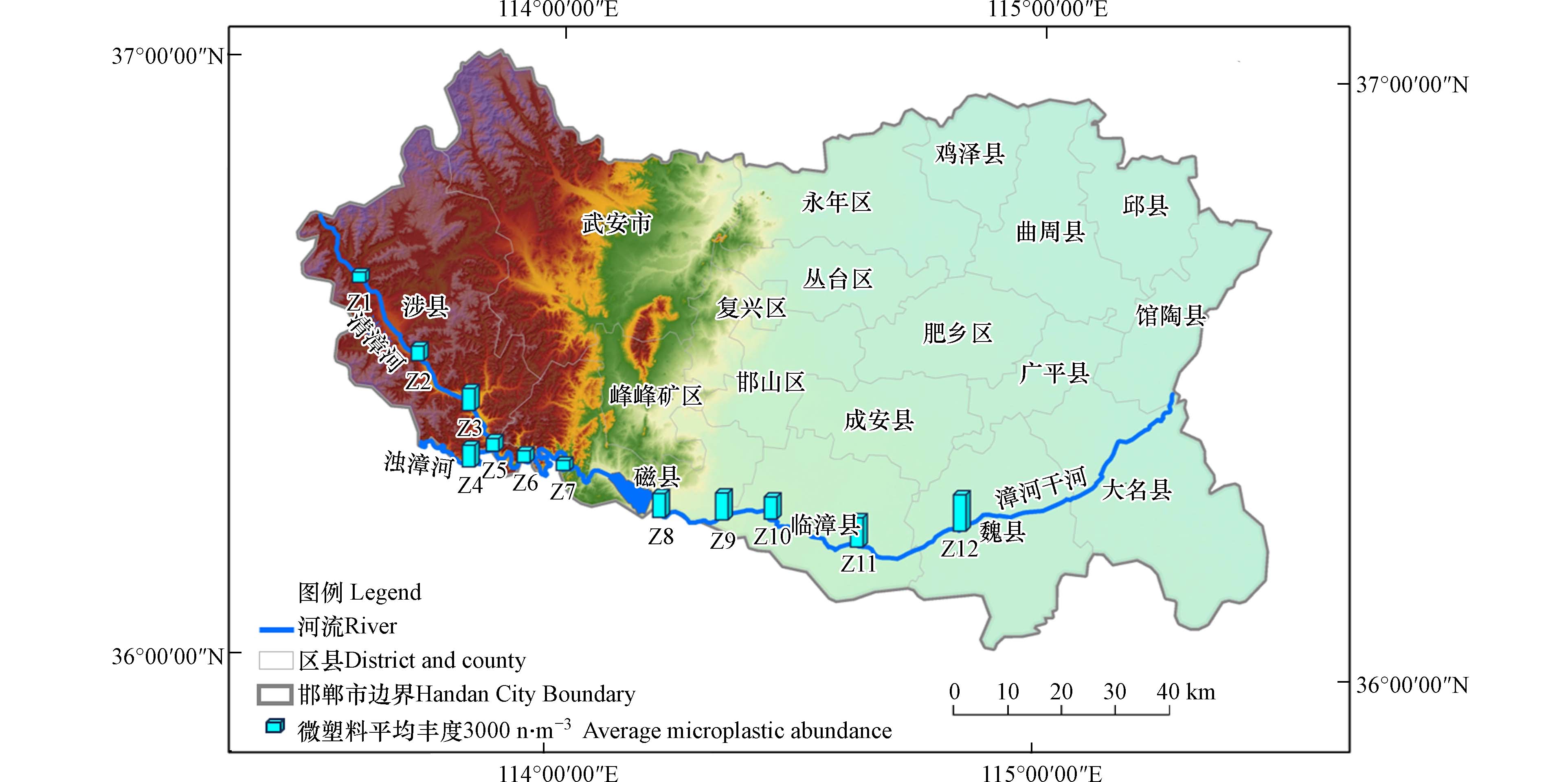
 下载:
下载:

